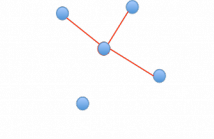
- Read more about Distributed Inference over Multitask Graphs under Smoothness
- Log in to post comments
- Categories:
 5 Views
5 Views
- Read more about Distributed Inference over Multitask Graphs under Smoothness
- Log in to post comments
- Categories:
 2 Views
2 Views
In this work, we jointly exploit tools from graph signal processing and control theory to drive a bandlimited graph signal that is being diffused on a random time-varying graph from a subset of nodes. As our main contribution, we rely only on the statistics of the graph to introduce the concept of controllability in the mean, and therefore drive the signal on the expected graph to a desired state.
- Categories:
 38 Views
38 Views
- Categories:
 29 Views
29 Views
- Read more about Feature LMS Algorithms
- Log in to post comments
In recent years, there is a growing effort in the learning algorithms area to propose new strategies to detect and exploit sparsity in the model parameters. In many situations, the sparsity is hidden in the relations among these coefficients so that some suitable tools are required to reveal the potential sparsity. This work proposes a set of LMS-type algorithms, collectively called Feature LMS (F-LMS) algorithms, setting forth a hidden feature of the unknown parameters, which ultimately would improve convergence speed and steady-state mean-squared error.
- Categories:
 23 Views
23 Views
- Read more about GM-PHD Filter Based Online Multiple Human Tracking using Deep Discriminative Correlation Matching
- Log in to post comments
poster.pdf
- Categories:
 42 Views
42 Views
- Read more about Automatic Shrinkage Tuning Robust to Input Correlation for Sparsity-Aware Adaptive Filtering (Poster)
- Log in to post comments
We propose a novel automatic shrinkage tuning technique for the adaptive proximal forward-backward splitting (APFBS) algorithm. The shrinkage tuning aims to choose an appropriate value of the shrinkage parameter and achieve minimal system mismatch as possible. The system mismatch is approximated based on time-averaged second-order statistics. Numerical examples show that the proposed method achieves performance fairly close to that with a manually chosen shrinkage parameter for colored input signals at some signal to noise ratio (SNR).
- Categories:
 10 Views
10 Views
- Read more about Feature LMS Algorithms
- Log in to post comments
In recent years, there is a growing effort in the learning algorithms
area to propose new strategies to detect and exploit
sparsity in the model parameters. In many situations, the
sparsity is hidden in the relations among these coefficients
so that some suitable tools are required to reveal the potential
sparsity. This work proposes a set of LMS-type algorithms,
collectively called Feature LMS (F-LMS) algorithms, setting
forth a hidden feature of the unknown parameters, which ultimately
would improve convergence speed and steady-state
- Categories:
 7 Views
7 Views